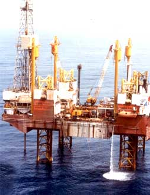 The long queues outside the CNG stations in your city should have disappeared by now.
The long queues outside the CNG stations in your city should have disappeared by now.
The lack of piped gas connectivity in your locality or industrial unit should also have become history.
At least, that's what the Ministry of Petroleum and Natural Gas had projected. According to the ministry, the country was supposed to have turned surplus in natural gas in the financial year that just went by (2009-10), despite a 5 per cent decline in gas production from Oil and Natural Gas Corporation (ONGC) and Oil India.
Besides Reliance Industries Ltd's production from the D6 fields at the Krishna-Godavari basin, the game changer was to be the Gujarat State Petroleum Corporation (GSPC), which was supposed to produce an additional 54 million standard cubic metres a day (mscmd) in 2009-10, leading to an oversupply of roughly 17 mscmd. The surplus took into account 52.5 mscmd LNG, according to the Eleventh Plan working group on petroleum.
But, the GSPC supply remained just a wishful thinking, even as 2009-10 drew to a close on March 31. The Gujarat government-owned exploration and production company now plans to start production in June 2012 and expects to reach a volume of 200 million standard cubic feet a day (4 mscmd) of gas in three to four years.
"We expect commercial production from Deendayal West (one KG field) to begin in June 2012 and are currently in the process of executing the field development plan for this block," says the company's draft red herring prospectus filed with Sebi.
GSPC's official spokesperson did not comment on the delay, but a senior GSPC executive denied the company had projected a production of 54 mscmd gas. "There is a natural timeframe for bringing such fields into production, so a delay is normal. Besides, creation of pipeline infrastructure and building production facilities will take time. I do not know where the government got the 54 mscmd figure," he added.
The Eleventh Plan working group report, however, was based on projections of the directorate general of hydrocarbons (DGH).
"DGH has projected expected additional supplies of 20, 30 and 40 mscmd from the RIL fields in 2009-10, 2010-11 and 2011-12, respectively, and 54 mscmd from GSPC in each of the above years. How much of these additional supplies would actually fructify would determine the prospects of the domestic supply scenario and would have a profound influence on the overall demand-supply balance," said the report.
It predicted two supply scenarios of 168.47 mscmd and an optimistic scenario of 242.47 mscmd that took into account an additional 74 mscmd domestic production.
The GSPC case is an example of projections going haywire, though not much is being talked about it, since gas supply is no longer viewed as a constraint and even the existing LNG terminals are working at just 25 mscmd, below their capacity of 44 mscmd.
Under the current demand scenario, this need for importing 25 mscmd, in fact, would have been totally wiped out had the GSPC production materialised.
Interestingly, there has even been a dip in demand projections. The demand is roughly 180-190 mscmd, lower than 225.52 mscmd anticipated for 2009-10 at the beginning of the Eleventh Five-Year Plan, said a senior petroleum ministry official.
"The capacity addition in gas-based power generation and the switch-over of fertiliser units to gas have not happened at a pace which was expected earlier. It is mainly because companies are not clear about long-term supply of gas," said the official.
A lot of demand was latent because of lack of pipeline infrastructure. Some of the gas-based power plants were operating at 70 per cent plant load factor, though gas was available to them and they could easily go up to 90 per cent, the official added.
The natural gas supply, including imported LNG, is currently around 160 mscmd. "The demand-supply gap can easily be met if the spare regassification capacity of LNG is used but with the availability of cheaper domestic gas, users are reluctant to buy LNG," said the official. If LNG terminals work their full capacity, there may even be a supply overhang.
City gas distribution (CGD) is one sector where there is a huge potential demand but infrastructure creation for it takes even longer. "Gas availability is no longer a constraint.
The challenge lies in creating infrastructure If one decides to set up a CGD network today, it will take 4-5 years to set up the infrastructure," said Rajesh Vedvyas, managing director of Indraprastha Gas Ltd, which supplies gas to Delhi and surrounding areas.
What has kept pace with the estimate at the beginning of the Plan period is the production from RIL's D6 field. Of the optimistic scenario predicted in the Plan, D6 was expected to bring in 20 mscmd more in 2009-10, taking its overall production to 60 mscmd.
Though D6 went into production one year later in April 2009, its present production is 60 mscmd with the field capable of producing 80 mscmd. But, due to lack of customers and pipeline capacity constraint, the company is unable to ramp up production.
The GSPC executive, however, dismissed the supply overhang debate, stating that the demand-supply mismatch will continue. "We will have a market. I do not see a surplus situation for at least five to 10 years. Gas has a tendency of developing a market wherever it goes."










